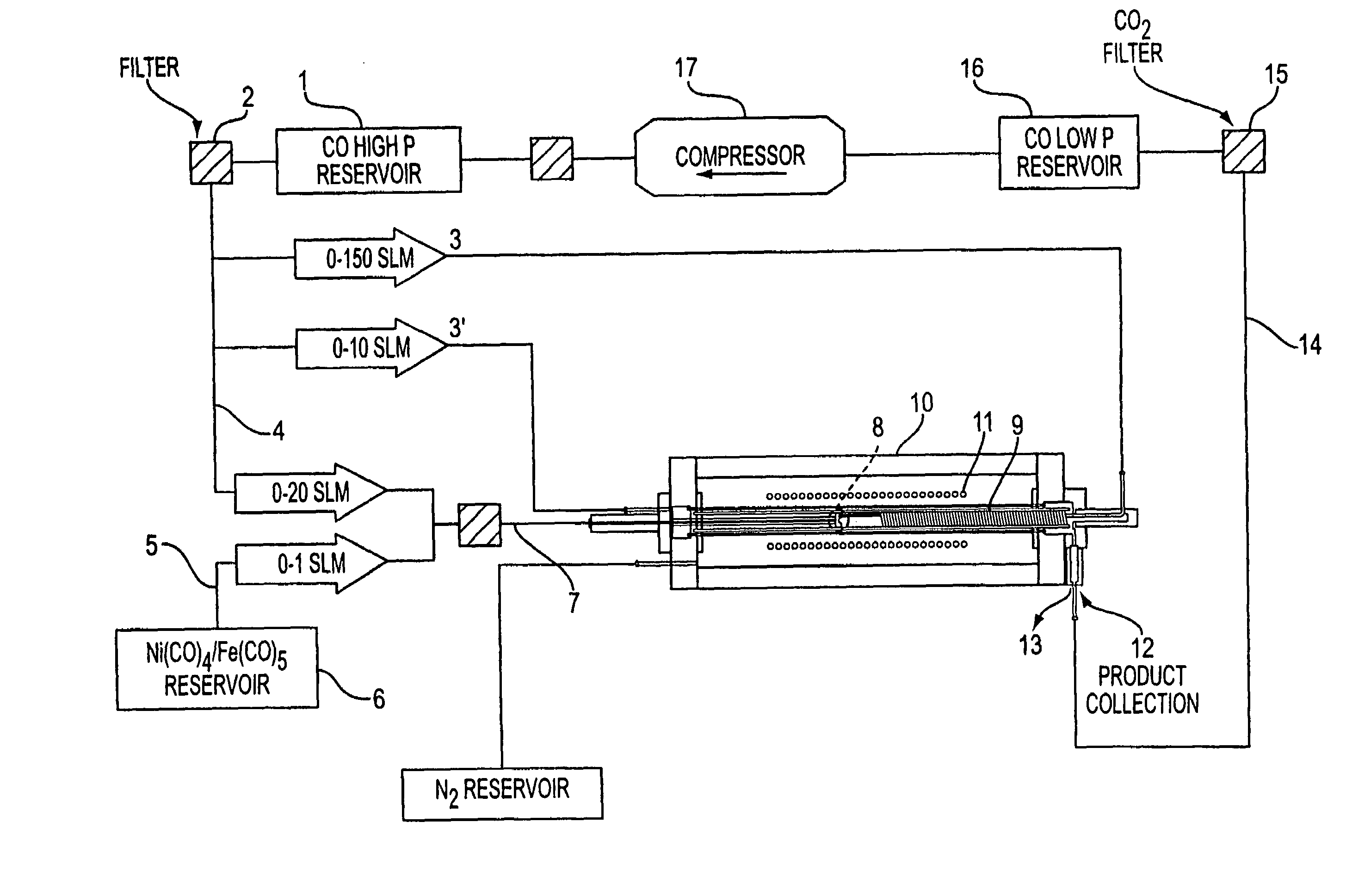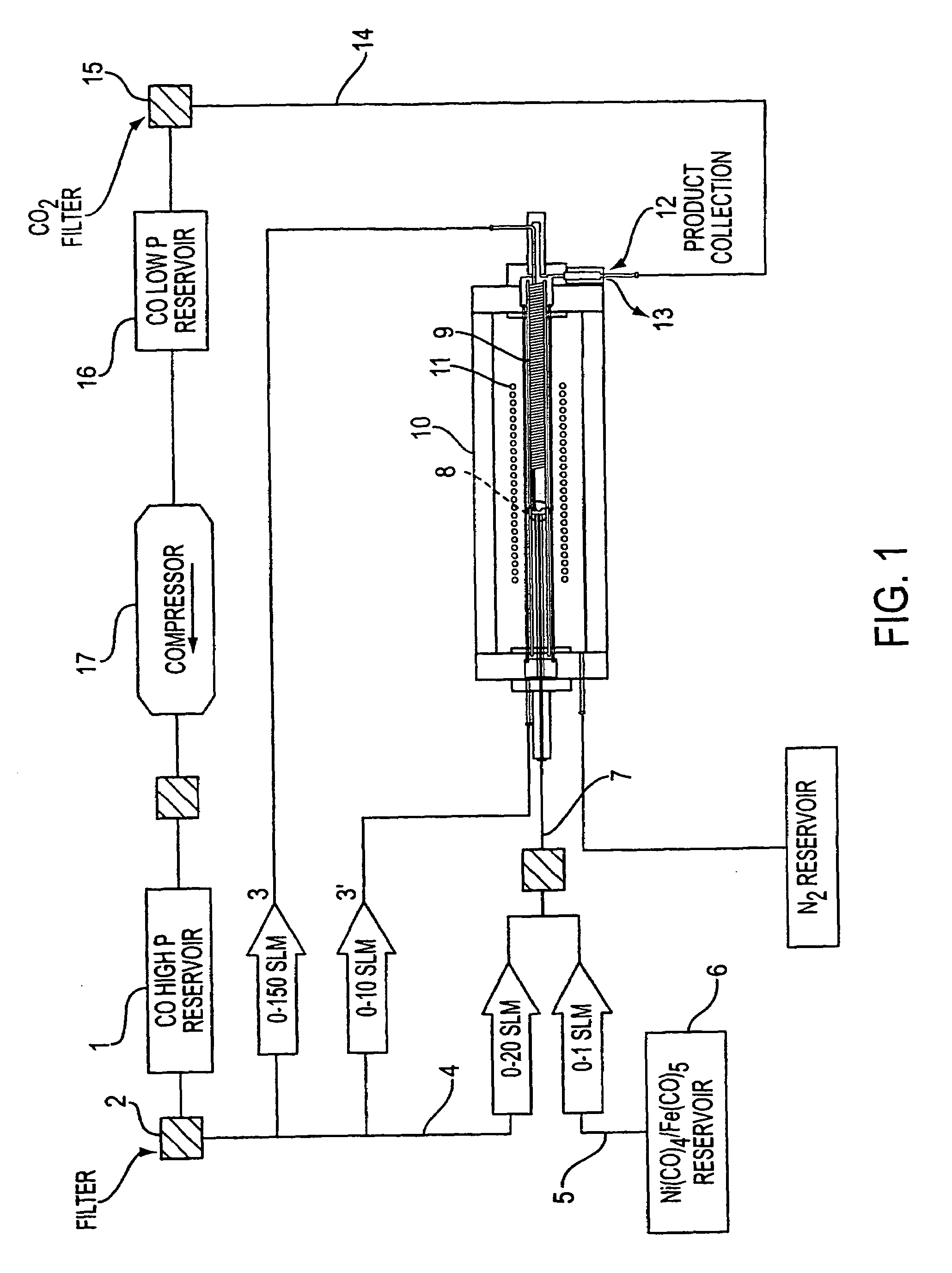Single-wall carbon nanotubes from high pressure CO
a carbon nanotube, high-pressure technology, applied in the direction of transportation and packaging, pressurized chemical process, energy-based chemical/physical/physical-chemical process, etc., can solve the problems of inherently costly, high energy consumption, and heterogeneous product of nanotubes
- Summary
- Abstract
- Description
- Claims
- Application Information
AI Technical Summary
Benefits of technology
Problems solved by technology
Method used
Image
Examples
example 1
[0069]This Example employed the apparatus shown in FIGS. 1 and 2 and demonstrates the process of the present invention is useful to produce clean SWNTs of small diameter.
Summary of Conditions:
[0070]
Operating Pressure: 600 psi (40 atmospheres) of COOperating Temp.900° C.
Flow Conditions:
[0071]Two standard liters per minute (slm) of CO containing 0.5 Torr of Fe(CO)5 were passed through the air-cooled injector. 8 slm of pure CO were preheated in the copper heating coil, and passed through the stainless steel injector manifold. The two flows were mixed in the mixing zone and the combined gases passed through the growth and annealing zone and into the product recovery zone.
[0072]Run time: 2 hours
[0073]Results:
[0074]17.5 mg of material was collected from the product recovery zone at the exit of the high pressure reactor. SEM measurements showed that this material was primarily SWNT. EDX and TGA measurements showed that this material contained 3–5 atom % of iron. TEM measurements showed tha...
example 2
[0075]Using the same apparatus as in Example 1, this Example demonstrates that Ni(CO)4 does not exhibit appreciable catalytic effects under the preferred higher pressure CO process conditions.
[0076]Summary of Conditions:
[0077]
Operating Pressure: 450 psi (30 atmospheres) of COOperating Temp.1000° C.
Flow Conditions:
[0078]2.5 standard liters per minute (slm) of CO containing 0.4 Torr of Ni(CO)4 were passed through the air-cooled injector. 7.5 slm of pure CO were preheated in the copper heating coil, and passed through the stainless steel injector manifold. The two flows were mixed in the mixing zone and the combined gases passed through the growth and annealing zone and into the product recovery zone.
[0079]Run time: 2 hours
[0080]Results:
[0081]Powdery material was collected from the product recovery zone at the exit of the high pressure reactor. This material was not weighed. SEM measurements showed that this material contained no SWNT; it was composed of metal particles overcoated with...
example 3
[0082]Again using the apparatus of Example 1, this Example shows that employing Ni(CO)4 as a nucleating agent substantially improves the productivity of the high pressure CO process.
Summary of Conditions:
[0083]
Operating Pressure: 450 psi (30 atmospheres) of COOperating Temp.1000° C.
Flow Conditions:
[0084]2.5 standard liters per minute (slm) of CO containing 0.2 Torr of Fe(CO)5 and 0.2 Torr of Ni(CO)4 were passed through the air-cooled injector. 7.5 slm of pure CO were preheated in the copper heating coil, and passed through the stainless steel injector manifold to the mixing zone where it was combined with the injector flow. The combined gases passed through the growth and annealing zone into the product recovery zone.
[0085]Run time: 2 hours
[0086]Results:
[0087]20.1 mg of material was collected from the product recovery zone at the exit of the high pressure reactor. SEM measurements showed that this material was primarily SWNT. EDX measurements showed that this material contained 1.2 ...
PUM
 Login to View More
Login to View More Abstract
Description
Claims
Application Information
 Login to View More
Login to View More - R&D
- Intellectual Property
- Life Sciences
- Materials
- Tech Scout
- Unparalleled Data Quality
- Higher Quality Content
- 60% Fewer Hallucinations
Browse by: Latest US Patents, China's latest patents, Technical Efficacy Thesaurus, Application Domain, Technology Topic, Popular Technical Reports.
© 2025 PatSnap. All rights reserved.Legal|Privacy policy|Modern Slavery Act Transparency Statement|Sitemap|About US| Contact US: help@patsnap.com



